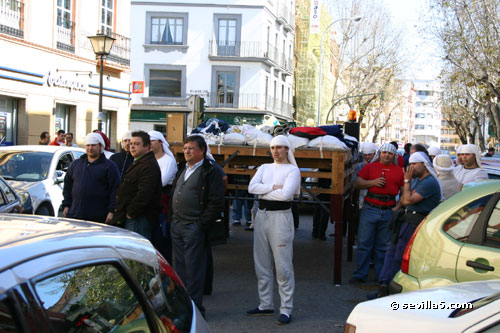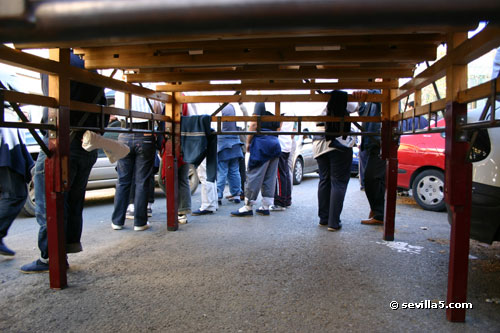Semana Santa Practice RunSeville, 5 March 2006The brotherhood from San Esteban Church makes a Sunday afternoon practice run for carrying the float, or paso, next month during Semana Santa.  The front row of 5 costaleros carrying the Semana Santa float of the San Esteban brotherhood. In preparation for Holy Week, the float carries only sand bags instead of the valuable artwork.  Taking a break at the edge of Menendez Pelayo.  The winter sun is already warming things up.  View of the stationary and unadorned float in the Puerta de Carmona, the location of the former gate in the city walls which led to the town of Carmona.  The structure is made out of plain, wooden beams, which explains the necessity for the costalero's head and neck protection.  The descanso is over, and the next group is getting into position under the float. Processions can last up to 12 hours, so it is necessary to have several shifts of costaleros to keep the float moving.  The float is lifted up: forward march!  Note the shoes made out of esparto.  Passing El Rincon del Nazareno, a shop specialized in Semana Santa outfits.  Lifting so much weight means it is quite crowded under the float.  This is called a llamador, and is used by the capataz to indicate when the float has to be lifted up and down. It is the only piece of artwork used for training. Note the crest of the San Esteban Church.  Much like a knocking on a door, it is raised and lowered, making a "clacking" sound. This is the last time before entering the church.  San Esteban street is completely blocked, and no car traffic can enter towards Plaza Alfalfa. This is much like the week of Semana Santa, when many streets into the center of the city are cut off from traffic.  Passing Bodega Extremeña, which is one of our favorite tapas bars. The thirsty costaleros will likely make a stop here after their practice. For now all eyes are on the road ahead.  An old car radio is used for the Semana Santa songs, as a real music band would be too difficult to arrange for the rehearsal. This is very important, as the costaleros must practice the rhythm and movements of the float, which is timed to the music. Note the warning light fixed on top of one of the speakers: there is often night practice on weekdays when few people are in the street.  The procession is arriving at San Esteban church, home of the brotherhood.  An important part of the training involves marking turns on narrow street corners, as seen here in front of the church entrance.  Without the figures on top of the float, entering through the door is rather easy, and nothing can break. San Esteban has the lowest doorway of all of the processions for Semana Santa. For this reason the entrance and exit of the procession is one of the most popular to watch. Getting a good viewpoint involves arriving at least 2 hours in advance.  Close to reaching a "parking" position.  The float is lowered down very carefully, as if the fragile artwork were already in place.  The crew is exhausted.  The end of today's training session, and the headwear can be rolled together. After duty it is typically held below one arm, while a cold Cruzcampo occupies the other... Close Window |
| Main Page | Apartments | Hotels | Hostels | Activities | Monuments | Sevilla Info | City Map
Telephone: ( 34) 954 387 550
sevilla5.com · C/ Feria, 80 · 41002 Sevilla
| About us | Contact | Sitemap |
Copyright © sevilla5.com 1999-2006. Privacy.